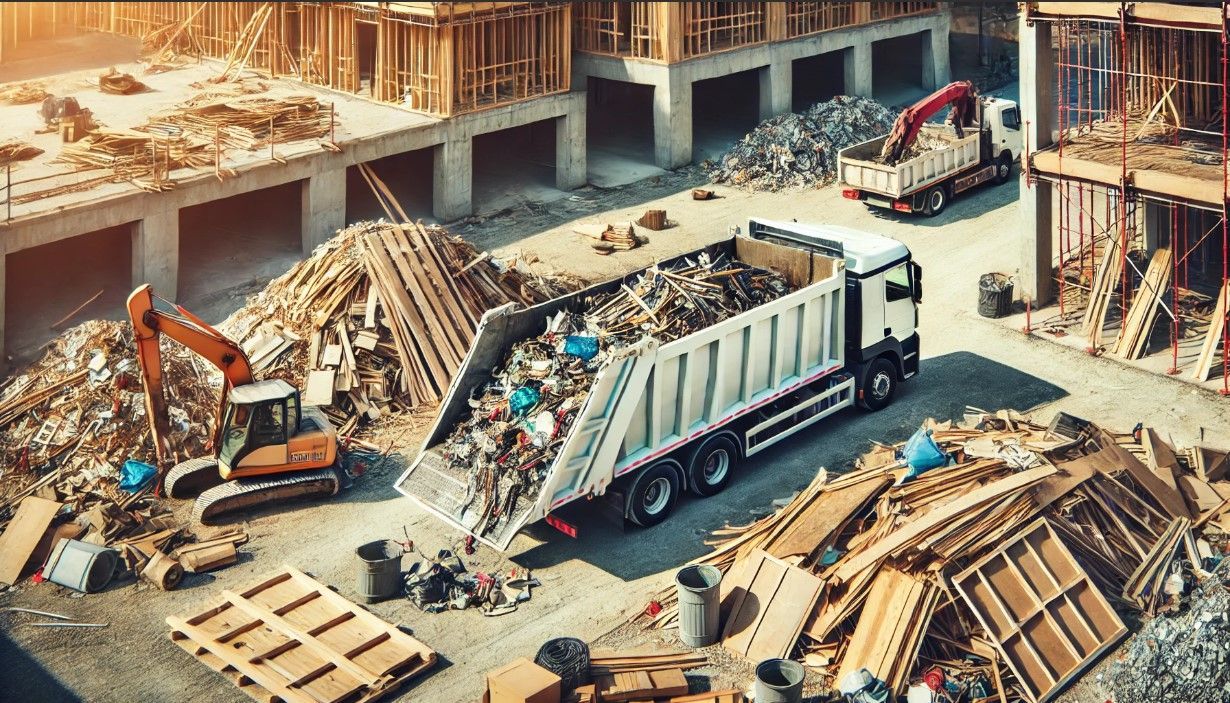
How to Handle Construction Debris Removal Efficiently and Safely
Got a construction project underway? While the build can be exciting, dealing with the aftermath isn't so fun.
Construction debris
piles up quickly, causing safety hazards and making your worksite messy. If not handled properly, it can slow down your project and add unnecessary costs. But don’t worry—debris removal doesn’t have to be a hassle. In this guide, we’ll cover how to handle construction debris
removal effectively, ensuring a clean and safe site.
What is Construction Debris and Why Should You Care?
Construction debris includes a variety of materials left over from construction, renovation, or demolition. It can consist of concrete, bricks, wood, metal, drywall, and more. Why is it important? Proper debris removal is key to keeping your site safe, clean, and compliant with local regulations. Plus, a clean site improves productivity and leaves a good impression on clients.
How to Remove Construction Debris Efficiently
1. Create a Debris Removal Plan
Before you start, outline a debris removal plan. Decide on what materials will be removed, how they will be separated (recyclables vs. trash), and where they will be disposed of. An organized plan saves time and ensures nothing gets left behind.
Benefits of Planning:
- Reduces Waste: A plan helps segregate recyclables and hazardous materials.
- Increases Efficiency: With a clear outline, your team knows what to do.
2. Separate Waste by Type
Sorting materials at the source can be a game-changer. Create separate piles or bins for different types of debris like wood, metal, and hazardous materials. Segregating waste makes it easier to recycle, dispose of, or reuse.
Pro Tip: Label bins clearly and place them strategically around the site. This encourages workers to sort materials as they go.
3. Use the Right Tools and Equipment
Investing in proper tools can make debris removal quicker and safer. Here are some items to consider:
- Wheelbarrows and Dollies: For moving heavy debris.
- Dumpsters and Skips: For collecting and transporting large quantities of waste.
- Heavy-Duty Bags: Ideal for small but sharp or heavy objects like nails and broken tiles.
- Protective Gear: Gloves, helmets, and masks keep your team safe from cuts, dust, and falling debris.
4. Consider Hiring a Professional Junk Removal Service
If debris removal seems overwhelming or you're short on time, consider hiring a professional junk removal service. These companies handle sorting, hauling, and disposal, allowing you to focus on your project.
Questions to Ask When Hiring a Service:
- Do they handle hazardous waste?
- What is their pricing structure (per load, hourly, or fixed)?
- Are they licensed and insured?
5. Dispose of Waste Responsibly
Each type of construction debris needs to be disposed of properly to comply with local regulations. Here’s a quick overview of disposal methods for common debris types:
| Material | Disposal Method |
|---|---|
| Wood | Recycle, reuse, or landfill |
| Concrete/Bricks | Recycle as fill material for new construction |
| Metal (e.g., steel, aluminum) | Recycle as scrap |
| Drywall/Plaster | Check local guidelines for proper disposal |
| Hazardous Material | Special disposal facilities |
6. Recycle and Reuse Where Possible
The eco-friendly route is always a good option. Recycle or donate usable materials like wood, metal, or certain types of plastics. Not only does this save on disposal costs, but it also reduces environmental impact.
Tips for Safe Construction Debris Removal
While efficiency is key, safety should never be overlooked. Here are some safety tips to keep in mind:
- Wear Proper Gear: Equip your team with gloves, helmets, masks, and steel-toed boots.
- Clear Pathways Regularly: Ensure pathways remain free of debris to prevent tripping hazards.
- Limit Overloading Bins: Overloaded bins can be difficult to move and can cause injury if they topple over.
- Train Your Team: Train workers on how to lift heavy items safely to avoid back injuries.
Frequently Asked Questions (FAQs)
Q1: Can I burn construction debris to get rid of it quickly?
A: No, burning construction debris is usually illegal and can release harmful toxins into the environment. Always check your local regulations before attempting this.
Q2: How do I know if a material is hazardous?
A: Hazardous materials include items like asbestos, lead paint, and certain chemicals. If you're unsure, consult your local environmental agency for proper identification and disposal guidelines.
Q3: What is the best time to remove debris from the site?
A: Ideally, debris should be removed as soon as it accumulates to maintain a safe and clean worksite. Scheduling a regular pickup (daily or weekly) can make this easier to manage.
Q4: How can I save money on construction debris removal?
A: Segregating materials for recycling and reusing items on-site can significantly reduce disposal costs. Additionally, shopping around for quotes from junk removal services helps find a cost-effective option.
Got any tips for handling construction debris removal efficiently? Have any stories to share about how you dealt with a particularly tricky cleanup? Share your thoughts and questions in the comments below!
If you found this guide helpful, don’t forget to share it on social media—your fellow contractors and DIY enthusiasts will thank you!
Keep Your Site Debris-Free and Efficient
Effective construction debris removal not only makes your site look professional but also improves safety and productivity. Remember to plan, separate waste, use the right tools, and dispose of everything responsibly. Stay efficient, stay safe!
Looking for a reliable junk removal service? Contact us today for a quote and let’s make your construction project cleaner and more efficient.

